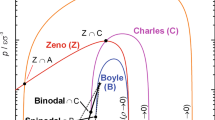Abstract
The dielectric constants and dielectric loss factors of aqueous solutions and suspensions are measured as a function of the specific electrical conductivity, temperature, and electric field frequency. The dispersion of the dielectric constant and the dielectric loss factor in solutions is explained by the formation of a electric double layer at the electrodes and the redistribution of the electric field between the region adjoining the electrodes and the remaining volume of the measuring cell. An equivalent-circuit calculations for suspensions displays acceptable agreement with experiment.
Similar content being viewed by others
Literature cited
A. N. Sus, V. V. Berezin, and I. P. Borovkova, Izv. Vyssh. Uchebn. Zaved., Fiz., No. 9, 133 (1971).
H. Frick and H. Curtis, J. Phys. Chem.,41, 729 (1937).
A. N. Efremov, in: Physics of Dielectrics [in Russian], Izd. Akad. Nauk SSSR, Moscow (1960).
G. I. Skanavi, Physics of Dielectrics (Weak-Field Domain) [in Russian], Gos. Izd. Tekh. i Teor. Lit., Moscow-Leningrad (1949).
N. P. Bogoroditskii, Yu. M. Volokobinskii, A. A. Vorob'ev, and B. M. Tareev, Theory of Dielectrics [in Russian], Energiya, Moscow-Leningrad (1965).
A. N. Frumkin, V. S. Bagotskii, Z. A. Iofa, and B. N. Kabanov, Kinetics of Electrode Processes [in Russian], Izd. Mos. Gos. Univ. (1952).
V. A. Odelevskit, Zh. Tekh. Fiz.,21, No. 6, 667 (1951).
D. A. Brugeman, Ann. Phys.,5, 24, 636 (1935).
C. E. Böttcher, Theory of Electric Polarization, Amsterdam (1942).
A. K. Veiberg, Dokl. Akad. Nauk SSSR,169, 3 (1966).
A. R. Von Hippel, Dielectrics and Waves, Wiley, New York (1954).
T. L. Chelidze and V. N. Shilov, in: Electrosurface Phenomena in Dispersive Systems [in Russian], Nauka, Moscow (1972).
S. S. Dukhin and V. N. Shilov, Dielectric Phenomena and the Double Layer in Dispersive Systems and Polyelectrolytes [in Russian], Naukova Dumka, Kiev (1972).
H. P. Schawan, G. Schwarz, J. Maczuk, and H. Pauly, J. Phys. Chem.,66, 2626 (1962).
S. Takasima, J. Phys. Chem.,70, 1372 (1966).
K. Wagner, Arch. Electrotech.,2, 371 (1914).
R. W. Sillars, J. Inst. Elect. Eng., London,80, 378 (1937).
Author information
Authors and Affiliations
Additional information
Translated from Izvestiya Vysshikh Uchebnykh Zavedenii, Fizika, No. 2 pp. 73–80, February, 1975.
Rights and permissions
About this article
Cite this article
Tonkonogov, M.P., Veksler, V.A. & Birzhanov, K.Z. Dielectric relaxation in aqueous solutions and suspensions I. Solutions and suspensions. Soviet Physics Journal 18, 205–211 (1975). https://doi.org/10.1007/BF01103929
Received:
Revised:
Issue Date:
DOI: https://doi.org/10.1007/BF01103929




